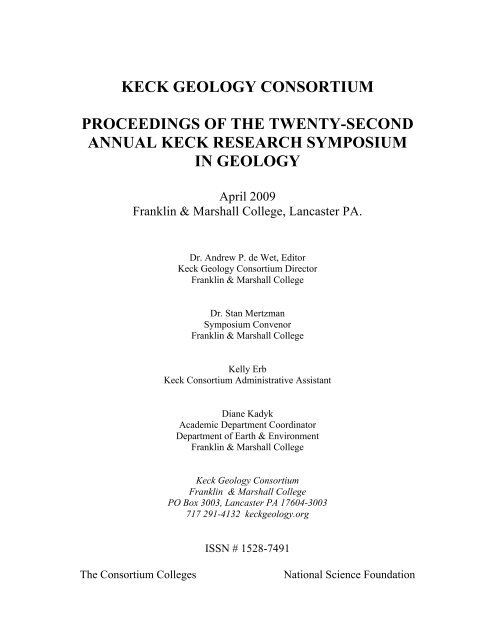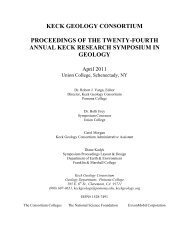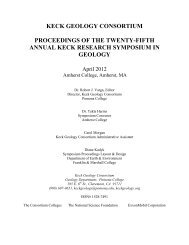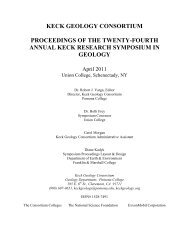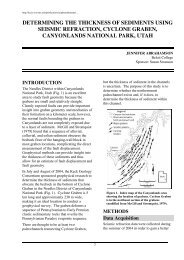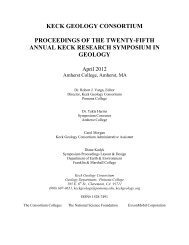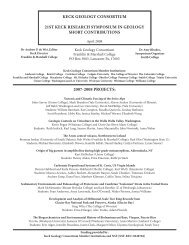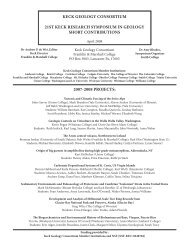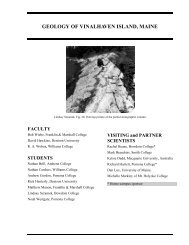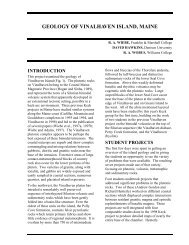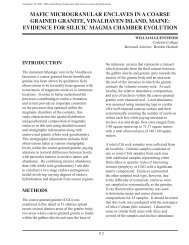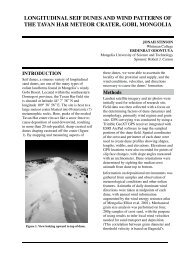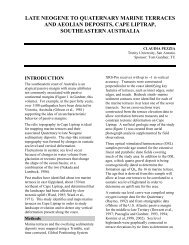alaskan climate of the late paleocene-early eocene as told by the ...
alaskan climate of the late paleocene-early eocene as told by the ...
alaskan climate of the late paleocene-early eocene as told by the ...
You also want an ePaper? Increase the reach of your titles
YUMPU automatically turns print PDFs into web optimized ePapers that Google loves.
KECK GEOLOGY CONSORTIUM<br />
PROCEEDINGS OF THE TWENTY-SECOND<br />
ANNUAL KECK RESEARCH SYMPOSIUM<br />
IN GEOLOGY<br />
April 2009<br />
Franklin & Marshall College, Lanc<strong>as</strong>ter PA.<br />
Dr. Andrew P. de Wet, Editor<br />
Keck Geology Consortium Director<br />
Franklin & Marshall College<br />
Dr. Stan Mertzman<br />
Symposium Convenor<br />
Franklin & Marshall College<br />
Kelly Erb<br />
Keck Consortium Administrative Assistant<br />
Diane Kadyk<br />
Academic Department Coordinator<br />
Department <strong>of</strong> Earth & Environment<br />
Franklin & Marshall College<br />
Keck Geology Consortium<br />
Franklin & Marshall College<br />
PO Box 3003, Lanc<strong>as</strong>ter PA 17604-3003<br />
717 291-4132 keckgeology.org<br />
ISSN # 1528-7491<br />
The Consortium Colleges<br />
National Science Foundation
KECK GEOLOGY CONSORTIUM<br />
PROCEEDINGS OF THE TWENTY-SECOND<br />
ANNUAL KECK RESEARCH SYMPOSIUM IN GEOLOGY<br />
ISSN# 1528-7491<br />
April 2009<br />
Andrew P. de Wet Keck Geology Consortium Stan Mertzman<br />
Editor & Keck Director Franklin & Marshall College Symposium Convenor<br />
Franklin & Marshall College PO Box 3003, Lanc. Pa, 17604 Franklin & Marshall C.<br />
Keck Geology Consortium Member Institutions:<br />
Amherst College, Beloit College, Carleton College, Colgate University, The College <strong>of</strong> Wooster, The Colorado College<br />
Franklin & Marshall College, Macalester College, Mt Holyoke College, Oberlin College, Pomona College, Smith College, Trinity University<br />
Union College, W<strong>as</strong>hington & Lee University, Wesleyan University, Whitman College, Williams College<br />
2008-2009 PROJECTS<br />
THE BLACK LAKE SHEAR ZONE: A POSSIBLE TERRANE BOUNDARY IN THE ADIRONDACK LOWLANDS<br />
(GRENVILLE PROVINCE, NEW YORK)<br />
Faculty: WILLIAM H. PECK, BRUCE W. SELLECK and MARTIN S. WONG: Colgate University<br />
Students: JOE CATALANO: Union College; ISIS FUKAI: Oberlin College; STEVEN HOCHMAN: Pomona College; JOSHUA T.<br />
MAURER: Mt Union College; ROBERT NOWAK: The College <strong>of</strong> Wooster; SEAN REGAN: St. Lawrence University; ASHLEY RUSSELL:<br />
University <strong>of</strong> North Dakota; ANDREW G. STOCKER: Claremont McKenna College; CELINA N. WILL: Mount Holyoke College<br />
PALEOECOLOGY & PALEOENVIRONMENT OF EARLY TERTIARY ALASKAN FORESTS, MATANUSKA VALLEY, AL.<br />
Faculty: DAVID SUNDERLIN: Lafayette College, CHRISTOPHER J. WILLIAMS: Franklin & Marshall College<br />
Students: GARRISON LOOPE: Oberlin College; DOUGLAS MERKERT: Union College; JOHN LINDEN NEFF: Amherst College;<br />
NANCY PARKER: Lafayette College; KYLE TROSTLE: Franklin & Marshall College; BEVERLY WALKER: Colgate University<br />
SEAFLOOR VOLCANIC AND HYDROTHERMAL PROCESSES PRESERVED IN THE ABITIBI GREENSTONE BELT OF<br />
ONTARIO AND QUEBEC, CANADA<br />
Faculty: LISA A. GILBERT, Williams College and Williams-Mystic and NEIL R. BANERJEE, U. <strong>of</strong> Western Ontario<br />
Students: LAUREN D. ANDERSON: Lehigh University; STEFANIE GUGOLZ: Beloit College; HENRY E. KERNAN: Williams College;<br />
ADRIENNE LOVE: Trinity University; KAREN TEKVERK: Haverford College<br />
INTERDISCIPLINARY STUDIES IN THE CRITICAL ZONE, BOULDER CREEK CATCHMENT, FRONT RANGE, CO<br />
Faculty: DAVID P. DETHIER: Williams College and MATTHIAS LEOPOLD: Technical University <strong>of</strong> Munich<br />
Students: EVEY GANNAWAY: The U. <strong>of</strong> <strong>the</strong> South; KENNETH NELSON: Macalester College; MIGUEL RODRIGUEZ: Colgate University<br />
GEOARCHAEOLOGY OF THE PODERE FUNGHI, MUGELLO VALLEY ARCHAEOLOGICAL PROJECT, ITALY<br />
Faculty: ROB STERNBERG: Franklin & Marshall College and SARA BON-HARPER: Monticello Department <strong>of</strong> Archaeology<br />
Students: AVERY R. COTA: Minnesota State University Moorhead; JANE DIDALEUSKY: Smith College; ROWAN HILL: Colorado<br />
College; ANNA PENDLEY: W<strong>as</strong>hington and Lee University; MAIJA SIPOLA: Carleton College; STACEY SOSENKO: Franklin and<br />
Marshall College<br />
GEOLOGY OF THE HÖH SERH RANGE, MONGOLIAN ALTAI<br />
Faculty: NICHOLAS E. BADER and ROBERT J. CARSON: Whitman College; A. BAYASGALAN: Mongolian University <strong>of</strong> Science and<br />
Technology; KURT L. FRANKEL: Georgia Institute <strong>of</strong> Technology; KARL W. WEGMANN: North Carolina State University<br />
Students: ELIZABETH BROWN: Occidental College; GIA MATZINGER, ANDREA SEYMOUR, RYAN J. LEARY, KELLY DUNDON and<br />
CHELSEA C. DURFEY: Whitman College; BRITTANY GAUDETTE: Mount Holyoke College; KATHRYN LADIG: Gustavus Adolphus<br />
College; GREG MORTKA: Lehigh U.; JODI SPRAJCAR: The College <strong>of</strong> Wooster; KRISTIN E. SWEENEY: Carleton College.<br />
BLOCK ISLAND, RI: A MICROCOSM FOR THE STUDY OF ANTHROPOGENIC & NATURAL ENVIRONMENTAL<br />
CHANGE<br />
Faculty: JOHAN C. VAREKAMP: Wesleyan University and ELLEN THOMAS: Yale University & Wesleyan University<br />
Students: ALANA BARTOLAI: Macalester College; EMMA KRAVET and CONOR VEENEMAN: Wesleyan University; RACHEL<br />
NEURATH: Smith College; JESSICA SCHEICK: Bryn Mawr College; DAVID JAKIM: SUNY.<br />
Funding Provided <strong>by</strong>: Keck Geology Consortium Member Institutions and NSF (NSF-REU: 0648782)
Keck Geology Consortium: Projects 2008-2009<br />
Short Contributions – Al<strong>as</strong>ka<br />
PALEOECOLOGY AND PALEOENVIRONMENT OF EARLY TERTIARY<br />
ALASKAN FORESTS, MATANUSKA VALLEY, ALASKA<br />
Project Faculty: DAVID SUNDERLIN: Lafayette College<br />
Project Faculty: CHRISTOPHER J. WILLIAMS: Franklin & Marshall College<br />
ALASKAN CLIMATE OF THE LATE PALEOCENE-EARLY EOCENE AS<br />
TOLD BY THE FOSSIL LEAVES OF THE CHICKALOON FORMATION<br />
GARRISON LOOPE: Oberlin College<br />
Research Advisor: Dennis Hubbard<br />
FISSION-TRACK AGES OF DETRITAL ZIRCON FROM THE PALEOCENE-<br />
EOCENE CHICKALOON AND WISHBONE FORMATIONS, MATANUSKA<br />
VALLEY, ALASKA<br />
DOUGLAS MERKERT: Union College<br />
Research Advisor: J.I. Garver<br />
SEDIMENTOLOGY, STRATIGRAPHPY, CHEMOSTRATIGRAPHY AND<br />
GEOCHRONOLOGY OF THE PALEOCENE-EOCENE CHICKALOON<br />
FORMATION, AK<br />
JOHN LINDEN NEFF: Amherst College<br />
Research Advisor: James W. Hagadorn<br />
A STUDY OF PLANT-INSECT INTERACTIONS IN THE PALEOCENE-<br />
EOCENE CHICKALOON FORMATION: PALEOECOLOGIC,<br />
PALEOCLIMATIC, AND PALEOLATITUDE IMPLICATIONS<br />
NANCY PARKER: Lafayette College<br />
Research Advisor: David Sunderlin<br />
GEOCHEMISTRY, MINERALOGY, AND MORPHOLOGY OF FOSSIL WOOD<br />
FROM THE LATE PALEOCENE-EARLY EOCENE CHICKALOON<br />
FORMATION<br />
KYLE TROSTLE: Franklin and Marshall College<br />
Research Advisor: Christopher J. Williams<br />
GASTROPOD ASSEMBLAGES FROM THE TERTIARY CHICKALOON<br />
FORMATION IN SOUTHERN ALASKA<br />
BEVERLY WALKER: Colgate University<br />
Research Advisor: Connie Soja<br />
Funding provided <strong>by</strong>: Keck Geology Consortium Member Institutions and NSF (NSF-REU: 0648782)<br />
Keck Geology Consortium<br />
Franklin & Marshall College<br />
PO Box 3003, Lanc<strong>as</strong>ter Pa, 17603<br />
Keckgeology.org
22nd Annual Keck Symposium: 2009<br />
ALASKAN CLIMATE OF THE LATE PALEOCENE-EARLY<br />
EOCENE AS TOLD BY THE FOSSIL LEAVES OF THE<br />
CHICKALOON FORMATION<br />
GARRISON LOOPE: Oberlin College<br />
Research Advisor: Dennis Hubbard<br />
INTRODUCTION<br />
As concern for <strong>the</strong> current <strong>climate</strong> crisis grows,<br />
climatologists look back to times <strong>of</strong> rapid <strong>climate</strong><br />
change in Earth’s p<strong>as</strong>t for clues that could help us<br />
understand <strong>the</strong> present. Of particular interest is <strong>the</strong><br />
Pal<strong>eocene</strong>-Eocene Thermal Maximum (PETM), a<br />
transient 170 ka warming event at about 55 Ma that<br />
is reflected in a ~3.5-4.5‰ negative carbon isotope<br />
excursion (Röhl et al., 2007). This isotopic shift is<br />
believed to be <strong>the</strong> result <strong>of</strong> a huge rele<strong>as</strong>e <strong>of</strong> methane,<br />
but <strong>the</strong> mechanism is still debated (Tripati et al.,<br />
2005; Storey et al., 2007). During <strong>the</strong> PETM Arctic<br />
Ocean sea-surface temperatures rose from 18º to a<br />
high <strong>of</strong> 23º C (Sluijs et al., 2006) while mid-continent<br />
terrestrial sites in Wyoming warmed to <strong>as</strong> high<br />
<strong>as</strong> 26º C mean annual temperature (MAT) (Fricke<br />
and Wing 2004). This rapid warming corresponds<br />
to a widespread benthic foraminiferal extinction<br />
(Thom<strong>as</strong>, 1998) and a major mammalian migration<br />
out <strong>of</strong> Asia (Bowen et al., 2002).<br />
High-resolution paleontological studies from <strong>the</strong><br />
intermontane b<strong>as</strong>ins <strong>of</strong> Wyoming have shown that<br />
MAT fluctuated dramatically in multiple pulses <strong>of</strong><br />
warming and cooling over a time scale <strong>of</strong> a few million<br />
years around <strong>the</strong> Pal<strong>eocene</strong>-Eocene boundary<br />
(Wing, 1998; Wilf, 2000). Fricke and Wing (2004)<br />
combined leaf-margin and oxygen-isotope data for<br />
16 <strong>early</strong> Eocene sites across North America to examine<br />
<strong>the</strong> latitudinal temperature gradient. They proposed<br />
that <strong>the</strong> gradient w<strong>as</strong> not <strong>as</strong> steep <strong>as</strong> it is today<br />
(0.4°C/1° latitude compared to 0.6°C/1° latitude<br />
today). This suggests greater warming at <strong>the</strong> poles,<br />
which is indicative <strong>of</strong> positive feedback processes.<br />
The most important polar feedback loop today is<br />
<strong>the</strong> melting <strong>of</strong> sea ice, but with an ice-free Arctic in<br />
<strong>the</strong> <strong>late</strong> Pal<strong>eocene</strong> ano<strong>the</strong>r feedback mechanisms is<br />
needed to explain this uneven warming.<br />
Several studies (Fricke and Wing, 2004; Wilf, 2000;<br />
Wing, 1998; Wing et al., 2005) have looked for<br />
climatic and floral change across <strong>the</strong> Pal<strong>eocene</strong>-Eocene<br />
boundary in North America but were largely<br />
restricted to sites in Wyoming and a few sites on <strong>the</strong><br />
Gulf Co<strong>as</strong>t and <strong>the</strong> Canadian Arctic. In order to<br />
more fully understand <strong>the</strong> interplay between <strong>climate</strong><br />
and biological change in <strong>the</strong> PETM, more data are<br />
needed from a wider geographic array <strong>of</strong> sites.<br />
This study examines one possible site in <strong>the</strong> Chickaloon<br />
Formation <strong>of</strong> <strong>the</strong> Matanuska Valley-Talkeetna<br />
Mountains forearc b<strong>as</strong>in <strong>of</strong> south-central Al<strong>as</strong>ka<br />
(Sunderlin and Williams, this volume). Paleomagnetic<br />
data put <strong>the</strong> region at a paleolatitude <strong>of</strong> 48º N<br />
± 11º during <strong>the</strong> deposition <strong>of</strong> <strong>the</strong> Chickaloon (Stamatakos<br />
et al., 1989). The goal <strong>of</strong> this project w<strong>as</strong> to<br />
provide a high-resolution picture <strong>of</strong> <strong>the</strong> uppermost<br />
beds <strong>of</strong> <strong>the</strong> Chickaloon with <strong>the</strong> hope <strong>of</strong> identifying<br />
<strong>the</strong> PETM within <strong>the</strong> section dated to <strong>the</strong> Pal<strong>eocene</strong>-Eocene<br />
boundary <strong>by</strong> Triplehorn et al. (1984).<br />
Over 370 fossil-bearing samples from 4 distinct beds<br />
were collected during <strong>the</strong> 2008 Al<strong>as</strong>ka Keck Project<br />
at <strong>the</strong> same Evan Jones Mine sampled <strong>by</strong> Triplehorn<br />
et al. (1984). I use four widely accepted leaf-physiognomy<br />
techniques to estimate climatic variables<br />
from <strong>the</strong>se beds, and make <strong>the</strong> c<strong>as</strong>e that climatic<br />
changes on <strong>the</strong> order <strong>of</strong> those envisioned for <strong>the</strong><br />
PETM are not reflected <strong>by</strong> <strong>the</strong> flora examined in <strong>the</strong><br />
upper Chickaloon Formation at <strong>the</strong> study site. The<br />
data presented in this study do however represent a<br />
climatically interesting period that should be more<br />
accurately dated and extensively analyzed in future<br />
studies.<br />
70
22nd Annual Keck Symposium: 2009<br />
METHODS<br />
This study w<strong>as</strong> part <strong>of</strong> <strong>the</strong> 2008 Keck Al<strong>as</strong>ka Project<br />
that sampled rocks near <strong>the</strong> Pal<strong>eocene</strong>-Eocene<br />
boundary in a 900m long, 100m deep pit at <strong>the</strong><br />
abandoned Evan Jones coal mine on <strong>the</strong> Wishbone<br />
Hill Syncline 3 miles northwest <strong>of</strong> Sutton, Al<strong>as</strong>ka<br />
(61º 44’ N, 148º 57’ W). Four beds ranging from<br />
15 to 50 cm in thickness were selected (designated<br />
G1-G4) (Fig.1). These beds were well indurated due<br />
to local carbonate cementation which facilitated <strong>the</strong><br />
recovery <strong>of</strong> whole specimens. Samples were collected<br />
from each bed until <strong>the</strong>y pinched out or became<br />
unreachable. Neff (this volume) shows <strong>the</strong> sampling<br />
locations <strong>of</strong> each bed.<br />
Samples were sorted into morphotypes using The<br />
Manual <strong>of</strong> Leaf Architecture (Wing et al., 1999) <strong>as</strong><br />
a guide. Wolfe and Leopold (1966), Hickey (1977),<br />
Brown (1962), and Hollick (1936) were used to help<br />
define ranges <strong>of</strong> variability <strong>of</strong> morphotypes and to<br />
match <strong>the</strong>m with described taxa. Each bed with<br />
sufficient morphotypes w<strong>as</strong> analyzed using four<br />
widely accepted leaf physiognomic techniques: two<br />
univariate MAT analyses both using <strong>the</strong> percent <strong>of</strong><br />
morphotypes with entire leaf margins, Leaf Margin<br />
Analysis (LMA; Wing and Greenwood 1993;<br />
Wilf, 1997), and Provisional Leaf Margin Analysis<br />
(PLMA; Kowalski and Dilcher 2003); one multivariate<br />
approach, Climate-Leaf Analysis Multivariate<br />
Program (CLAMP; Wolfe, 1995); and a univariate<br />
mean annual precipitation analysis, Leaf Area<br />
Analysis (LAA; Wilf et al., 1998). Each technique<br />
is b<strong>as</strong>ed on a separate algorithm, but all <strong>of</strong> <strong>the</strong>m use<br />
<strong>the</strong> same primary character to estimate mean annual<br />
temperature, proportion <strong>of</strong> leaves with an entire<br />
margin (Fig.2).<br />
Figure 2. The Aesculus hickeyi leaflet on <strong>the</strong> left h<strong>as</strong> a serrate<br />
margin, while <strong>the</strong> leaf on <strong>the</strong> right (Morphotype 3:13) h<strong>as</strong> an<br />
entire margin<br />
RESULTS<br />
Figure 1. Three corre<strong>late</strong>d composite stratigraphic sections in<br />
<strong>the</strong> Evan Jones mine with <strong>as</strong>sociated ∂C12BOC(%) (Bulk organic<br />
Carbon) curves. A, B and C are derived from e<strong>as</strong>t, central,<br />
and west sides <strong>of</strong> <strong>the</strong> site respectively. Approximate positions<br />
<strong>of</strong> G1-G4 are shown. PCZ is <strong>the</strong> zone identified <strong>by</strong> Triplehorn <strong>as</strong><br />
containing <strong>the</strong> Pal<strong>eocene</strong>-Eocene boundary.<br />
The 370 samples taken from four beds in <strong>the</strong> upper<br />
Chickaloon Formation yielded a total <strong>of</strong> 38 discrete<br />
dicot leaf morphotypes <strong>as</strong> well <strong>as</strong> abundant Equisetum,<br />
Haemanthophyllum, and Met<strong>as</strong>equoia fossils.<br />
Beds G3 and G2 contained <strong>the</strong> highest numbers <strong>of</strong><br />
morphotypes with 21 and 20 respectively; beds G1<br />
and G4 contained 12 and 11. Table 1 summarizes<br />
<strong>the</strong> distribution <strong>of</strong> <strong>the</strong>se morphotypes across beds.<br />
Only two morphotypes (Dombeya novi-mundi, and<br />
2:10) are found in non-adjacent beds without being<br />
71
22nd Annual Keck Symposium: 2009<br />
present in intermediate beds. Each bed had a few<br />
morphotypes that dominated <strong>the</strong> collection and at<br />
le<strong>as</strong>t a few unique forms not shared with any o<strong>the</strong>r<br />
bed. These unique occurrences tended to be fairly<br />
rare even within a single bed. G3 had <strong>the</strong> most<br />
<strong>of</strong> <strong>the</strong>se unique forms with 8 out <strong>of</strong> 21 total types<br />
found only within <strong>the</strong> bed. All beds shared <strong>the</strong><br />
majority <strong>of</strong> <strong>the</strong>ir morphotypes with o<strong>the</strong>r beds and<br />
none <strong>of</strong> <strong>the</strong> forms that dominated were unique.<br />
Mean annual temperature<br />
B<strong>as</strong>ed on <strong>the</strong> three analyses, mean annual temperature<br />
varied between 7.5º and 13.8°C across all sites<br />
(Fig. 3). G2, G3, and <strong>the</strong> composite run (using all<br />
38 morphotypes) are similar for each <strong>of</strong> <strong>the</strong> analyses<br />
with LMA estimating <strong>the</strong> lowest temperatures<br />
(11.2-11.8º), PLMA estimating <strong>the</strong> highest (13.9-<br />
14.6º), and CLAMP falling in between (13-13.7º).<br />
G1 and G4 have lower MAT estimates from LMA<br />
and PLMA than G2 and G3 but <strong>the</strong>y also have<br />
larger standard deviations and are too small to run<br />
CLAMP.<br />
Estimates <strong>of</strong> Mean Annual Temperature<br />
19<br />
17<br />
15<br />
Table 1. Beds are ordered stratigraphically from lowest on left<br />
to highest on right. “X” represents presence <strong>of</strong> morphotype<br />
while “X” signifies a dominant morphotype<br />
MAT (Cº)<br />
13<br />
11<br />
9<br />
7<br />
5<br />
G1 G3 G2 G4 composite<br />
CLAMP<br />
LMA<br />
PLMA<br />
value is b<strong>as</strong>ed on an estimated 7.5 month growing<br />
se<strong>as</strong>on so is difficult to compare to data from LAA.<br />
CLAMP also shows that <strong>the</strong> area did not experience<br />
a severe dry se<strong>as</strong>on because three driest months had<br />
an estimated 39 cm precipitation.<br />
Figure 3. A comparison between <strong>the</strong> three methods <strong>of</strong> finding<br />
mean annual temperature used in this study; CLAMP, LMA, and<br />
PLMA. Error bars show one standard deviation.<br />
Precipitation<br />
The two beds (G2, G3) with enough species to run<br />
leaf area analysis had similar mean annual precipitation<br />
values (160.3 and 158.9 cm/yr; Table 1). These<br />
are close to <strong>the</strong> value derived in a composite run<br />
(154.6 cm/yr). CLAMP predicts mean growing se<strong>as</strong>on<br />
precipitation <strong>of</strong> about 118 cm for all beds. This<br />
DISCUSSION<br />
The beds described in this study were deposited in<br />
a fluvial system at low elevation close to <strong>the</strong> Pacific<br />
Ocean (Trop et al. 2003). The <strong>climate</strong> appears to<br />
have been moist year-round with a mean annual<br />
precipitation close to 150 cm. The different analyses<br />
yielded a large amount <strong>of</strong> variation in estimates<br />
<strong>of</strong> MAT ranging from 7.8º for LMA in G1 to 14.6º<br />
for PLMA in G3. The large standard deviations<br />
<strong>as</strong>sociated with <strong>the</strong>se estimates make it difficult to<br />
discern whe<strong>the</strong>r this variation is real or <strong>the</strong> result<br />
72
22nd Annual Keck Symposium: 2009<br />
Table 2. Precipitation estimates for beds with >20 morphotypes.<br />
All CLAMP categories have a single reported standard deviation<br />
shown at bottom <strong>of</strong> table<br />
<strong>of</strong> factors not addressed <strong>by</strong> <strong>the</strong> methods or insufficient<br />
sampling. Beds G1 and G4 have <strong>by</strong> far <strong>the</strong><br />
coolest estimated MAT but have scarcely half <strong>as</strong><br />
many morphotypes <strong>as</strong> G2 and G3. The low number<br />
<strong>of</strong> morphotypes makes it impossible to run CLAMP<br />
and c<strong>as</strong>ts some doubt on <strong>the</strong> beds with cooler temperatures.<br />
The data from <strong>the</strong> two most statistically robust beds,<br />
G2 and G3, both suggest a MAT between 11.5º and<br />
14.5º C. All beds contain abundant Equisetum,<br />
and Haemanthophyllum, both <strong>of</strong> which are known<br />
to have been common riparian and wetland taxa.<br />
PLMA is designed to work best for riparian and<br />
wetland sites while LMA does not acknowledge<br />
<strong>the</strong> dominance <strong>of</strong> <strong>the</strong>se environments in <strong>the</strong> fossil<br />
record. This suggests that for this study PLMA<br />
may be more appropriate so temperatures are more<br />
likely to range from 13º to 14.5º C. Although this is<br />
considerably warmer than today (~1.5º C at Sutton,<br />
AK), it is lower than expected for rocks <strong>of</strong> this age in<br />
Al<strong>as</strong>ka, and well below any re<strong>as</strong>onable estimate for<br />
PETM.<br />
Wolfe and Leopold (1966) reports that <strong>the</strong> entire<br />
flora <strong>of</strong> <strong>the</strong> Chickaloon represented subtropical conditions<br />
due to <strong>the</strong> presence <strong>of</strong> fan palms and tropical<br />
genera such <strong>as</strong> Macaranga and Dennstaedtia. He<br />
also found that n<strong>early</strong> 50% <strong>of</strong> species in <strong>the</strong> formation<br />
had entire margins suggesting temperatures<br />
upward <strong>of</strong> 18º C. Wolfe (1977) describes <strong>the</strong> <strong>early</strong><br />
Ravenian (middle Eocene) <strong>of</strong> sou<strong>the</strong>rn Al<strong>as</strong>ka <strong>as</strong><br />
paratropical with MAT ranging from 20-25º C with<br />
65% <strong>of</strong> species having entire margins. The beds described<br />
in this study lack <strong>the</strong> tropical taxa found <strong>by</strong><br />
Wolfe and Leopold (1966) and my analyses indicate<br />
73<br />
considerably cooler temperatures. However, Wolfe<br />
describes <strong>the</strong> <strong>climate</strong> b<strong>as</strong>ed on an amalgam <strong>of</strong> <strong>the</strong><br />
entire Chickaloon which m<strong>as</strong>ks transient episodes <strong>of</strong><br />
<strong>climate</strong> change such <strong>as</strong> <strong>the</strong> PETM. It is unlikely that<br />
any <strong>of</strong> <strong>the</strong> beds in this study represent <strong>the</strong> PETM because<br />
<strong>of</strong> <strong>the</strong> absence <strong>of</strong> a strong negative carbon-isotope<br />
excursion (Neff, this volume) and <strong>the</strong> relatively<br />
low MAT estimates reported here. Studies from<br />
Wyoming show that <strong>the</strong> PETM w<strong>as</strong> <strong>as</strong>sociated with<br />
a 5º incre<strong>as</strong>e in MAT over b<strong>as</strong>eline temperatures<br />
and a radical shift in floral composition (Wing et al.,<br />
2005). The composition <strong>of</strong> <strong>the</strong> ecosystems preserved<br />
in beds G1-G4 does seem to be shifting, but not in a<br />
radical way. Most common morphotypes are shared<br />
between beds, and a change in flora between beds is<br />
most likely a result <strong>of</strong> chance preservation and <strong>late</strong>rally<br />
migrating vegetation zones that adjust to stream<br />
course.<br />
High-resolution studies such <strong>as</strong> this can provide<br />
important information about <strong>the</strong> nature <strong>of</strong> rapid<br />
<strong>climate</strong> change, but <strong>by</strong> <strong>the</strong>ir nature <strong>the</strong>y are unable<br />
to cover large swaths <strong>of</strong> geologic time. Although<br />
this study is unable to identify <strong>the</strong> PETM in <strong>the</strong><br />
Chickaloon, I believe that beds G1-G4 lie just tens<br />
<strong>of</strong> meters above <strong>the</strong> PETM b<strong>as</strong>ed on <strong>the</strong> work <strong>of</strong><br />
Triplehorn et al. (1984). It appears that <strong>the</strong> beds described<br />
<strong>by</strong> Triplehorn are now buried under a mine<br />
reclamation project, so future studies will need to<br />
examine <strong>the</strong> numerous o<strong>the</strong>r pits in <strong>the</strong> area to find<br />
corresponding strata. Wing et al. (1998) found that<br />
about 500 ky after <strong>the</strong> end <strong>of</strong> <strong>the</strong> PETM temperatures<br />
dropped from over 18ºC MAT to around 11ºC<br />
in <strong>the</strong> upper Haplomylus-Ectocion Zone (UHEZ)<br />
before rising again. If Triplehorn et al. (1984) were<br />
correct in <strong>the</strong>ir date, <strong>the</strong> unexpectedly low temperatures<br />
reported in this study may correspond to <strong>the</strong><br />
low temperatures <strong>of</strong> <strong>the</strong> UHEZ reported <strong>by</strong> Wing<br />
(1998). As <strong>of</strong> now this is little more than pure speculation,<br />
and more work on <strong>the</strong> precise chronology <strong>of</strong><br />
<strong>the</strong> upper Chickaloon needs to be done to provide<br />
any concrete evidence for this supposition.<br />
REFERENCES<br />
Brown, R. 1962. Pal<strong>eocene</strong> Flora <strong>of</strong> <strong>the</strong> Rocky
22nd Annual Keck Symposium: 2009<br />
Mountains and Great Plains. Geological Survey<br />
Pr<strong>of</strong>essional Paper 375.<br />
Bowen, G. Clyde, W., Koch, P., Ting, S., Alroy, J.,<br />
Tsubamoto, T., Wang, Y., Wang, Y. Mammalian<br />
Dispersal at <strong>the</strong> Pal<strong>eocene</strong>/Eocene Boundary.<br />
Science. v. 295, p. 2062-2065<br />
Fricke, H., Wing, S. 2004. Oxygen isotope and<br />
paleobotanical estimates <strong>of</strong> temperature and<br />
dO18 –Latitude gradients over North America<br />
during <strong>the</strong> <strong>early</strong> Eocene. American Journal <strong>of</strong><br />
Science Vol. 304, 612-635.<br />
Hickey, L. 1977. Stratigraphy and Paleobotany <strong>of</strong><br />
<strong>the</strong> Golden Valley formation (Early Tertiary) <strong>of</strong><br />
Western North Dakota. Geological Society <strong>of</strong><br />
America Memoir 150.<br />
Hollick, A. 1936. Tertiary flor<strong>as</strong> <strong>of</strong> Al<strong>as</strong>ka. USGS.<br />
Pr<strong>of</strong>essional Paper 182.<br />
Kowalski, E., Dilcher, D. 2003. Warmer paleotemperatures<br />
for terrestrial ecosystems. Proceedings<br />
<strong>of</strong> <strong>the</strong> National Academy <strong>of</strong> Sciences. V.<br />
100, No. 1, 167-170.<br />
Röhl, U., Westerhold, T., Bralower, T. J., and Zachos,<br />
J. C. 2007. On <strong>the</strong> duration <strong>of</strong> <strong>the</strong> Pal<strong>eocene</strong>-<br />
Eocene <strong>the</strong>rmal maximum (PETM), Geochem.<br />
Geophys. Geosyst., V.8, N. 12.<br />
Sluijs, A., Schouten, S., Pagani, M., Woltering, M.,<br />
Brinkhuis, H., Damste, J.S.S., Dickens, J.R., Huber,<br />
M., Reichart, G.J., Stein, R., Matthiessen,<br />
J., Lourens, L.J., Pedentchouk, N., Backman,<br />
J., Moran, K. 2006. Subtropical Arctic Ocean<br />
temperatures during <strong>the</strong> Pal<strong>eocene</strong>/ Eocene<br />
<strong>the</strong>rmal maximum. Nature. Vol. 441, pg. 610-<br />
613.<br />
Stamatakos, J.A., Kodama, K.P., Vittorio, L.F., and<br />
Pavlis, T.L., 1989, Paleomagnetism <strong>of</strong> Cretaceous<br />
and Pal<strong>eocene</strong> sedimentary rocks across<br />
<strong>the</strong> C<strong>as</strong>tle Mountain fault, south- central Al<strong>as</strong>ka,<br />
in Hillhouse, J.W., ed., Deep structure and<br />
p<strong>as</strong>t kinematics <strong>of</strong> accreted terranes: American<br />
Geophysical Union Geophysical Monograph<br />
Series 50: 151–177.<br />
Storey, M., Duncan, R. A., Swisher, C. C. 2007.<br />
Pal<strong>eocene</strong>-Eocene Thermal Maximum and <strong>the</strong><br />
Opening <strong>of</strong> <strong>the</strong> Nor<strong>the</strong><strong>as</strong>t Atlantic. Science. V.<br />
316, p 587-589.<br />
Thom<strong>as</strong>, E. 1998. Biogeography <strong>of</strong> <strong>the</strong> Late Pal<strong>eocene</strong><br />
Benthic Foraminiferal Extinction. In Late<br />
Pal<strong>eocene</strong>-Early Eocene Climatic and Biotic<br />
Events in <strong>the</strong> Marine and Terrestrial Records,<br />
Editors. Aubry, M. Luc<strong>as</strong>, S., Berggren, W.<br />
Tripati, A., Elderfield, H. 2005. Deep-Sea Temperature<br />
and Circulation changes at <strong>the</strong> Pal<strong>eocene</strong>-<br />
Eocene Thermal Maximum. Science. V. 308, p<br />
1894-1898.<br />
Triplehorn, D., Turner, D., Naeser, C. 1984. Radiometric<br />
age <strong>of</strong> <strong>the</strong> Chickaloon Formation <strong>of</strong><br />
south-central Al<strong>as</strong>ka: Location <strong>of</strong> <strong>the</strong> Pal<strong>eocene</strong>-Eocene<br />
boundary. Geological society <strong>of</strong><br />
America Bulletin. V. 97, 740-742.<br />
Trop, J., Ridgway, K., Spell, T. 2003. Sedimentary<br />
record <strong>of</strong> transpressional tectonics and ridge<br />
subduction in <strong>the</strong> Tertiary Matanuska Valley-<br />
Talkeetna Mountains forearc b<strong>as</strong>in sou<strong>the</strong>rn<br />
Al<strong>as</strong>ka. Geological Society <strong>of</strong> America Special<br />
Paper 371.<br />
Wilf, P. 1997. When are leaves good <strong>the</strong>rmometers?<br />
A new c<strong>as</strong>e for Leaf Margin Analysis. Paleobiology.<br />
23(3): 373-390.<br />
Wilf, P., Wing, S., Greenwood, D.R., Greenwood,<br />
C.L. 1998. Using fossil leaves <strong>as</strong> paleoprecipitation<br />
indicators: An Eocene example. Geology. v.<br />
26; no.3; p. 203-6.<br />
Wilf, P. 2000. Late Pal<strong>eocene</strong>–<strong>early</strong> Eocene <strong>climate</strong><br />
changes in southwestern Wyoming:<br />
Paleobotanical analysis. GSA Bulletin. v.11;<br />
no.2; 292-307<br />
Wing, S.L. 1998. Late Paleogene-Early Eocene Floral<br />
74
22nd Annual Keck Symposium: 2009<br />
and Climatic Change in <strong>the</strong> Bighorn B<strong>as</strong>in,<br />
Wyoming. In Late Pal<strong>eocene</strong>-Early Eocene<br />
Climatic and Biotic Events in <strong>the</strong> Marine and<br />
Terrestrial Records, Editors. Aubry, M. Luc<strong>as</strong>,<br />
S., Berggren, W.<br />
Wing, S. L. 1999. Manual <strong>of</strong> Leaf Architecture.<br />
Smithsonian Institution.<br />
Wing, S., Harrington, G., Smith, F., Bloch, J., Boyer,<br />
D., Freeman, K. 2005. Rapid Global Warming<br />
at <strong>the</strong> Pal<strong>eocene</strong>-Eocene Boundary. Science.<br />
Vol. 310, 992-996.<br />
Wolfe, J., Hopkins, D., Leopold, E. 1966. Tertiary<br />
Stratigraphy and Paleobotany <strong>of</strong> <strong>the</strong> Cook Inlet<br />
Region, Al<strong>as</strong>ka. Geological Survey Pr<strong>of</strong>essional<br />
Paper 398-A and B.<br />
Wolfe, J. 1977. Paleogene Flor<strong>as</strong> From <strong>the</strong> Gulf <strong>of</strong><br />
Al<strong>as</strong>ka Region. Geological Survey Pr<strong>of</strong>essional<br />
Paper 997.<br />
Wolfe, J. 1995. Paleoclimatic estimates from Tertiary<br />
leaf <strong>as</strong>semblages. Annu. Rev. Earth Planet.<br />
Sci. 23:119-142.<br />
75


